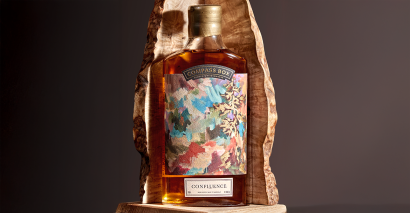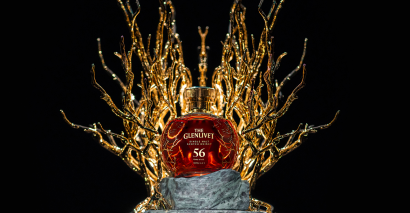_1920.jpg?resize=1920x0)
Conceived back in the 1990s, The Rare American Whiskey Selection was to be an annual release of collectible American whiskeys. The idea was ahead of its time, but the project was aborted before launch and never saw the light of day. The only existing set of the original edition was sold at auction last week by Sotheby's New York. Photos courtesy of Sotheby's
The Collection That Might Have Altered the Course of Whiskey History
April 17, 2023 –––––– David Fleming
It’s a forgotten piece of whiskey’s past, from back in the 1990s, brought to light by an auction held on April 14th at Sotheby’s in New York. The item was a collection of ultra-aged, ultra-premium American whiskeys called The Rare American Whiskey Selection, conceived as an annual series by one of the biggest companies in the business. At the time it was an unusual concept in American whiskey, to say the least.
The idea came from United Distillers, a forerunner to Diageo. In addition to its prowess in scotch, the company had sizable holdings in American whiskey, including the acquired assets of Schenley, Glenmore, and Stitzel Weller. But in the late 1980s and early ’90s, American whiskey was in a sorry state. A generation of young drinkers had turned up its nose at brown spirits, favoring imported vodka and California chardonnay—and leaving whiskey companies desperately seeking solutions to the problem.
United Distillers thus created a luxury subsidiary called The Classic Kentucky Bourbon Company, hoping to change people’s attitudes about whiskey. The unit’s first project was The Rare American Whiskey Selection—an annual release of five different barrel proof, ultra-aged whiskeys with an inaugural run of 6,000 bottles. The whiskeys included in this first edition were to be from the age-old distilleries of Old Quaker, Stitzel Weller, George T. Stagg, Taylor Williams, and Buffalo Springs, with age statements that ranged between 15 and 21 years.
It was a concept ahead of its time. Prior to the launch, the company bottled two prototype sets of this collection. One was sent to corporate headquarters in London, and the other was kept at Stitzel Weller Distillery in Kentucky. Everything was set to roll when in the spring of 1997, United Distillers parent company Guinness announced plans for a mega-merger with Grand Metropolitan to form Diageo. The Rare American Whiskey Selection initiative was shelved, and it was never revived.
Had this project seen the light of day, it would have created a landmark moment in the history of American whiskey. Its release would have pre-dated the Buffalo Trace Antique Collection by several years. It most certainly would have transformed the profile of American whiskey in the global auction market, rocketing it to a lofty status it has achieved only in the last couple of years. It might even have created enough buzz to help reignite the entire American whiskey scene, well before the modern renaissance got underway.
The prototype collection kept at Stitzel Weller is believed to have been destroyed in a fire, leaving the set at Diageo headquarters as the only one in existence. This past week, Sotheby’s put that collection up for auction. It sold for 15 times its pre-sale estimate, reaching a value of $148,991/$187,245 (including premiums) and setting a new record for an American whiskey sale. After a three-way bidding war, an American private collector emerged as the winner. The rest of us will be left to imagine what might have been._600.jpg)
Here are the names, ages, and distillation dates of the whiskeys in The Rare American Whiskey Selection, just sold by Sotheby’s. While some of these names won’t be recognized by modern-day drinkers as belonging to Diageo, at one point in history they all did indirectly, through a series of acquisitions in the 1980s and 1990s.
- Old Quaker Indiana Corn Whiskey 21 year old Limited Edition Barrel Proof (distilled in 1976), 65% ABV
- Taylor & Williams Kentucky Straight Bourbon Limited Edition 17 year old Barrel Proof (distilled in 1980), 56% ABV
- Stitzel-Weller Kentucky Straight Bourbon Limited Edition 17 year old Barrel Proof (distilled in 1980), 53.5% ABV
- George T Stagg Kentucky Straight Rye Limited Edition 16 year old Barrel Proof (distilled in 1981), 57% ABV
- Buffalo Springs Kentucky Rye Mash Limited Edition 15 year old Barrel Proof (distilled in 1982), 62.5% ABV
About the Distilleries of the Above Whiskeys
•Old Quaker Distillery was right next door to Seagram (today’s MGP) in Lawrenceburg, Indiana. It was owned by Schenley for a time, and Schenley was acquired by United Distillers (Diageo) in 1987, so United Distillers likely had a supply of Old Quaker in its warehouses.
•Stitzel Weller in Shively, Kentucky was acquired from the Van Winkles by a forerunner company of United Distillers/Diageo in the early 1970s.
•Taylor & Williams Distillery (also in Shively) was owned by Glenmore, which also was acquired by UD/Diageo in 1991.
•Stagg, today’s Buffalo Trace Distillery, was owned by Schenley for a time, so UD likely ended up with some Stagg inventory after its Schenley deal.
•Buffalo Springs Distillery was founded in 1868 in Georgetown, Kentucky, just outside Lexington, and closed a century later. It too became part of Schenley. Part of its physical structure in Georgetown today is an inn of the same name, Buffalo Springs Distillery.




